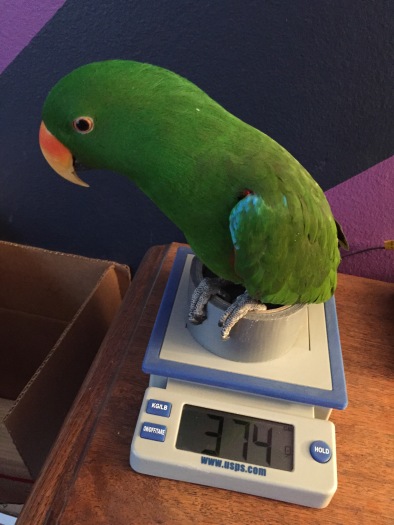It’s no secret that birds hide their illnesses; by the time the standard bird owner notices that her bird is acting mildly sick, her feathered friend is often knocking on death’s door.

Typical avian illness symptoms include fluffed feathers, a loss of appetite (this can be mild at first and hardly noticed), being quieter than usual, tail bobbing, and if things are really bad, you’ll find your friend on the floor of his or her cage one morning.
Sometimes, they’ll seem perky and alert as they look up at you from the floor of their cage.
Sometimes, they are quite clearly dying.
How do you protect your feathered friends when they are masters of disguise?
It’s possible to predict the future and possibly prevent a tragedy with one simple trick:
Buy a gram scale. Weigh your bird in the morning.
There is one simple sign many parrot owners overlook that can be the canary in the cave of your bird’s health, and that sign is your parrot’s weight.
Weighing your parrot regularly could save your feathered friend’s life, especially if he or she is a newer member to your flock.
Take Louie: He came home with us at the beginning of last summer, otherwise known as during the “comp time” for all the sixty-seventy hour weeks we put in during the school year as teachers (smack anyone who tells you teachers “get summers off”–we earn them, darn it.)
We had three months of round-the-clock, home-always happiness with our little man.
But, the summer of our much-content had to come to an end at some point, and we weren’t sure how our jolly green man would adjust to waking up four hours earlier–would he be grumpy? Sleepy since he was now only getting eight hours plus naps rather than an unbroken twelve hours? We had nothing to compare it to and weren’t sure what to expect.
One week into the school year, he seemed a little tired. Just a touch. Quieter in the evenings–he was still eating generally the same amount. Maybe a bit less, based on observations.
It was because we were weighing him regularly that we caught his illness, and caught it early.
Louie was, ah, a touch on the bovine-side weight-wise when first we brought him home (apparently a diet of cheese, meat, pellets, and peanuts doesn’t bode well for ekkies).
The week before school began, we were weighing him every other morning or so.
His initial morning weigh-in was a whopping 394, on the heavy side for a Solomon Island Ekkie (other types of ekkies usually weigh more than this). One week into the school year, and he’d dropped to 370 during his morning weigh-in, a loss of nearly 24 grams.
This worried us, and with our experience losing our baby before, we didn’t wait. We called and set up an appointment for the earliest opportunity, which was the next day.
The night before we brought him in, he was lethargic. Tired. Sitting, mute, on his tiny perch, and leaning off to one side, barely able to keep his eyes open.
The next morning, he weighed in at 355.

Dr. LB put him on an antibiotic immediately, suspecting a bacterial infection. Louie hated the syringe, so I ended up dousing small pieces of bread with the medicine and feeding it to him, crumb by crumb, to make sure he took every last drop.
Within twenty-four hours, he was UP. Peppy. Perky, talking, kissing our cheeks, and back to romancing our feet with a vengeance. Because we’d only known him a few months, we weren’t able to spot his initially mild change in behavior.
We’d assumed he was just tired/acting differently because we weren’t home the way we had been. If we hadn’t been weighing him, it might have been too late.
But because we weighed him every few days or so, we were able to spot the subtlest of signs of illness, make the appointment, and take care of our little man.
Today, he weighs a healthy 373, which is just about perfect for a Solomon Island Ekkie. =) It fluctuates here and there, but nothing shouts “sick!” like a twenty gram + drop in weight!


2 thoughts on “A First Sign of Illness: A Bird’s Weight”